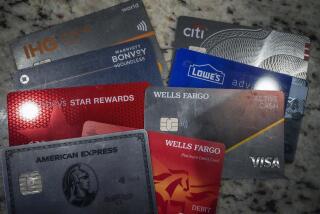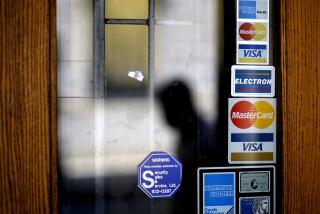A mixed report on loan payments
WASHINGTON — Late payments on credit card bills slipped in the second quarter while delinquencies on home equity lines of credit climbed to a 5 1/2 -year high, painting a mixed picture of how people are managing their debt.
The American Bankers Assn., in its quarterly survey of consumer loans, reported Wednesday that late payments on credit card bills dropped to 4.39% in the April-to-June quarter. That was down from 4.41% in the first quarter and was the lowest reading since the final quarter of 2005.
The improvement, however, came before a credit crunch took a turn for the worse in August. Problems with sub-prime mortgages -- made to people with spotty credit or low incomes -- have rocked Wall Street in recent months.
Still, James Chessen, the association’s chief economist, was heartened by the survey’s overall results. “Consumers fared reasonably well in the second quarter despite turmoil in the sub-prime mortgage market,” he said.
A still-sturdy employment climate and wage growth during the April-to-June quarter helped to cushion people from the ill effects of a deepening housing slump. Those positive forces have “helped to limit spillover to other consumer loans,” Chessen said.
In August, however, the economy lost jobs for the first time in four years. Although economists hope for a jobs rebound, any continued weakness could put a strain on some people’s ability to pay their bills on time.
Payments are considered delinquent if they are 30 or more days past due. The survey is based on information supplied by more than 300 banks.
The survey also showed that the delinquency rate on a composite of other types of consumer loans -- including those for autos and boats, home improvement and for certain home equity loans -- decreased to 2.27% in the second quarter from 2.42% in the first quarter.
Late payments on home equity lines of credit, however, rose to 0.77%. That was up from 0.60% in the first quarter and was the highest reading since the final quarter of 2001.
The Federal Reserve’s decision last week to slice a key interest rate for the first time in four years should provide borrowers some relief.
It will become less expensive for people to finance certain credit card debt and for homeowners to take out home equity lines of credit, which often are used to pay for education, home improvements or medical bills.
More to Read
Inside the business of entertainment
The Wide Shot brings you news, analysis and insights on everything from streaming wars to production — and what it all means for the future.
You may occasionally receive promotional content from the Los Angeles Times.









